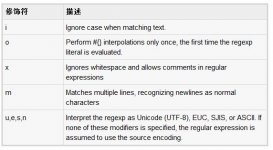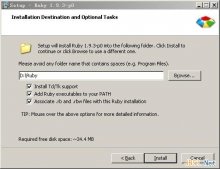在笔者开发的系统中,有大量的数据需要分析,不仅要求数据分析准确,而且对速度也有一定的要求的。没有写测试代码之前,笔者用几个很大的方法来实现这种需求。结果可想而知,代码繁杂,维护困难,难于扩展。借业务调整的机会,笔者痛定思痛,决定从测试代码做起,并随着不断地学习和应用,慢慢体会到测试代码的好处。
- 改变思路:能做到从需求到代码的过程转换,逐步细化;
- 简化代码:力图让每个方法都很小,只专注一件事;
- 优化代码:当测试代码写不出来,或者需要写很长的时候,说明代码是有问题的,是可以被分解的,需要进一步优化;
- 便于扩展:当扩展新业务或修改旧业务时,如果测试代码没有成功,则说明扩展和修改不成功;
- 时半功倍:貌似写测试代码很费时,实际在测试、部署和后续扩展中,测试代码将节省更多的时间。
环境搭建
笔者采用的测试环境是比较流行通用的框架:RSpec + Factory Girl,并用autotest自动工具。RSpec是一种描述性语言,通过可行的例子描述系统行为,非常容易上手,测试用例非常容易理解。Factory Girl可以很好的帮助构造测试数据,免去了自己写fixture的烦恼。Autotest能自动运行测试代码,随时检测测试代码的结果,并且有很多的插件支持,可以让测试结果显示的很炫。
第一步 安装rspec和rspec-rails
在命令行中执行如下命令:
|
1
2
|
$ sudo gem install rspec v = 1.3.0$ sudo gem install rspec-rails v = 1.3.2 |
安装完成后,进入rails应用所在的目录,运行如下脚本,生成spec测试框架:
|
1
2
3
4
5
6
7
8
9
|
$ script/generate rspec exists lib/tasks identical lib/tasks/rspec.rake identical script/autospec identical script/spec exists spec identical spec/rcov.opts identical spec/spec.opts identical spec/spec_helper.rb |
第二步 安装factory-girl
在命令行中执行如下命令:
|
1
2
|
$ sudo gem install rspec v = 1.3.0$ sudo gem install rspec-rails v = 1.3.2 |
安装完成后,进入rails应用所在的目录,运行如下脚本,生成spec测试框架:
|
1
2
3
4
5
6
7
8
9
|
$ script/generate rspec exists lib/tasks identical lib/tasks/rspec.rake identical script/autospec identical script/spec exists spec identical spec/rcov.opts identical spec/spec.opts identical spec/spec_helper.rb |
第二步 安装factory-girl
在命令行中执行如下命令:
|
1
|
$ sudo gem install factory-girl |
在config/environment/test.rb中,加入factory-girl这个gem:
|
1
|
config.gem "factory_girl" |
在spec/目录下,增加一个factories.rb的文件,用于所有预先定义的model工厂。
第三步 安装autotest
在命令行中执行如下命令:
|
1
2
|
$ sudo gem install ZenTest$ sudo gem install autotest-rails |
然后设置与RSpec的集成,在rails应用的目录下,运行如下的命令,就可以显示测试用例的运行结果。
RSPEC=true autotest or autospec
在自己的home目录下,增加一个.autotest设置所有的Rails应用的autotest插件。当然,也可以把这个文件加到每个应用的根目录下,这个文件将覆盖home目录下的文件设置。autotest的插件很多,笔者用到如下的plugin:
|
1
2
3
|
$ sudo gem install autotest-growl$ sudo gem install autotest-fsevent$ sudo gem install redgreen |
设置.autotest文件,在.autotest中,加入如下代码。
|
1
2
3
4
5
6
7
8
9
|
require 'autotest/growl'require 'autotest/fsevent'require 'redgreen/autotest'Autotest.add_hook :initialize do |autotest| %w{.git .svn .hg .DS_Store ._* vendor tmp log doc}.each do |exception| autotest.add_exception(exception) endend |
测试经验
安装了必要的程序库以后,就可以写测试代码了。本例中,所有应用都是在Rails 2.3.4上开发的,RSpec采用的是1.3.0的版本。为了很好的说明问题,我们假定这样的需求:判断一个用户在一个时间段内是否迟到。写测试代码时都是遵循一个原则,只关心输入和输出,具体的实现并不在测试代码的考虑范围之内,是行为驱动开发。根据这个需求,我们将会设计方法absence_at(start_time,end_time),有两个输入值start_time和end_time以及一个输出值,类型是boolean。对应的测试代码如下:
|
1
2
3
4
5
6
7
8
9
10
11
12
13
14
15
16
17
|
describe "User absence or not during [start_time,end_time]" do before :each do @user = Factory(:user) end it "should return false when user not absence " do start_time = Time.utc(2010,11,9,12,0,0,0) end_time = Time.utc(2010,11,9,12,30,0) @user.absence_at(start_time,end_time).should be_false end it "should return true when user absence " do start_time = Time.utc(2010,11,9,13,0,0,0) end_time = Time.utc(2010,11,9,13,30,0) @user.absence_at(start_time,end_time).should be_ture endend |
测试代码已经完成。至于absence_at方法我们并不关心它的实现,只要这个方法的结果能让测试代码运行结果正确就可以。在此测试代码的基础上,就可以大胆地去完成代码,并根据测试代码的结果不断修改代码直到所有测试用例通过。
Stub的使用
写测试代码,最好首先从model开始。因为model的方法能很好与输入输出的原则吻合,容易上手。最初的时候,你会发现mock和stub很好用,任何的对象都可以mock,并且在它的基础上可以stub一些方法,省去构造数据的麻烦,一度让笔者觉得测试代码是如此美丽,一步步的深入,才发现自己陷入了stub的误区。还是引用上面的例子,我们的代码实现如下:
|
1
2
3
4
5
6
|
class User < ActiveRecord::Base def absence_at(start_time,end_time) return false if have_connection_or_review?(start_time,end_time) return (login_absence_at?(start_time,end_time) ? true : false) endend |
按照最初写测试代码的思路,本方法中存在三种情况,即需要三个用例,而且还调用了其他两个方法,需要对他们进行stub,于是就有了下面的测试代码。记得当时完成后还很兴奋,心中还想:这么写测试代码真有趣。
|
1
2
3
4
5
6
7
8
9
10
11
12
13
14
15
16
17
18
19
20
21
22
23
24
25
26
27
|
before(:each) do @user = User.newenddescribe "method <absence_at(start_time,end_time)>" do s = Time.now e = s + 30.minutes # example one it "should be false when user have interaction or review" do @user.stub!(:have_connection_or_review?).with(s,e).and_return(true) @user.absence_at(s,e).should be_false end # example two it "should be true when user has no interaction and he no waiting at platform" do @user.stub!(:have_connection_or_review?).with(s,e).and_return(false) @user.stub!(:login_absence_at?).with(s,e).and_return(true) @user.absence_at(s,e).should be_true end # example three it "should be false when user has no interaction and he waiting at platform" do @user.stub!(:have_connection_or_review?).with(s,e).and_return(false) @user.stub!(:login_absence_at?).with(s,e).and_return(false) @user.absence_at(s,e).should be_false endend |
上面的测试代码,是典型把代码的实现细节带到了测试代码中,完全是本末倒置的。当然这个测试代码运行的时候,结果都是正确的。那是因为用stub来假定所有的子方法都是对的,但是如果这个子方法have_connection_or_review?发生变化,它不返回boolean值,那么将会发生什么呢?这个测试代码依然正确,可怕吧!这都没有起到测试代码的作用。
另外,如果是这样,我们不仅要修改have_connection_or_review?的测试代码,而且还要修改absence_at的测试代码。这不是在增大代码维护量吗?
相比而言,不用stub的测试代码,不用修改,如果Factory的数据没有发生变化,那么测试代码的结果将是错误的,因为have_connection_or_review?没有通过测试,导致absence_at方法无法正常运行。
其实stub主要是mock一些本方法或者本应用中无法得到的对象,比如在tech_finish?方法中,调用了一个file_service来获得Record对象的所有文件,在本方法测试代码运行过程中,无法得到这个service,这时stub就起作用了:
|
1
2
3
4
5
6
7
8
9
10
11
12
13
14
|
class A < ActiveRecord::Base has_many :records def tech_finish? self.records.each do |v_a| return true if v_a.files.size == 5 end return false endendclass Record < ActiveRecord::Base belongs_to :a has_files # here is a service in gemend |
所对应的测试代码如下:
|
1
2
3
4
5
6
7
8
9
10
11
12
13
14
15
|
describe "tech_finish?" do it "should return true when A's records have five files" do record = Factory(:record) app = Factory(:a,:records=>[record]) record.stub!(:files).and_return([1,2,3,4,5]) app.tech_finish?.should == true end it "should return false when A's records have less five files" do record = Factory(:record) app = Factory(:a,:records=>[record]) record.stub!(:files).and_return([1,2,3,5]) app.tech_finish?.should == false endend |
Factory的使用
有了这个工厂,可以很方便的构造不同的模拟数据来运行测试代码。还是上面的例子,如果要测试absence_at方法,涉及到多个model:
-
HistoryRecord:User的上课记录
-
Calendar:User的课程表
-
Logging:User的日志信息
如果不用factory-girl构造测试数据,我们将不得不在fixture构造这些测试数据。在fixture构造的数据无法指定是那个测试用例使用,但是如果用Factory的话,可以为这个方法专门指定一组测试数据。
|
1
2
3
4
5
6
7
8
9
10
11
12
13
14
15
16
17
18
19
20
|
Factory.define :user_absence_example,:class => User do |user| user.login "test" class << user def default_history_records [Factory.build(:history_record,:started_at=>Time.now), Factory.build(:history_record,:started_at=>Time.now)] end def default_calendars [Factory.build(:calendar), Factory.build(:calendar)] end def default_loggings [Factory.build(:logging,:started_at=>1.days.ago), Factory.build(:logging,:started_at=>1.days.ago)] end end user.history_records {default_history_records} user.calendars {default_calendars} user.loggings {default_loggings}end |
这个测试数据的构造工厂,可以放在factories.rb文件中,方便其他测试用例使用,也可以直接放到测试文件的before中,仅供本测试文件使用。通过factory的构造,不仅可以为多个测试用例共享同一组测试数据,而且测试代码也简洁明了。
|
1
2
3
|
before :each do @user = Factory.create(:user_absence_example)end |
Readonly的测试
在笔者的系统中,大量使用了acts_as_readonly,从另外一个数据库来读取数据。由于这些model并不在本系统中,所以当用Factory构造测试数据的时候,总会有问题。虽然也可以使用mock来达到这个目的,但是由于mock的局限性,还是无法灵活的满足构造测试数据的需要。为此,扩展了一些代码,使得这些model依然可以测试。核心思想则是,根据配置文件的设置,将对应的readonly的表创建在测试数据库,这个操作在运行测试之前执行,这样就达到与其他model一样的效果。site_config配置文件中,关于readonly的配置格式如下:
|
1
2
3
4
5
|
readonly_for_test: logings: datetime: created_at string: status integer: trainer_id |
Gem的测试
Gem在Rails中被广泛使用,而且是最基础的东西,因此它的准确无误就显得更加重要。在不断实践的基础上,笔者所在的团队总结出一种用spec测试gem的方法。假设我们要测试的gem是platform_base,步骤如下:
1. 在gem的根目录下创建一个目录spec(路径为platform_base/spec)。
2. 在gem的根目录下创建文件Rakefile(路径为platform_base/Rakefile),内容如下:
|
1
2
3
4
5
6
7
8
9
|
require 'rubygems'require 'rake'require 'spec/rake/spectask'Spec::Rake::SpecTask.new('spec') do |t| t.spec_opts = ['--options', "spec/spec.opts"] t.spec_files = FileList['spec/**/*_spec.rb']end |
3. 文件在spec目录下创建spec.opts(路径为platform_base/spec/spec.opts),内容如下:
--format progress
--loadby mtime
--reverse
4. 在spec目录下,创建一个Rails app,名为test_app。这个新应用需要有spec目录和spec_helper.rb文件。
5. 为了保持简化,把这个新app(test_app)整理一下,删除vendor和public目录,最终的结构如下:
|- app
|- config
| |- environments
| |- initializers
| |- app_config.yml
| |- boot.rb
| |- database.yml
| |- environment.rb
| \- routes.rb
|- db
| \- test.sqlite3
|- log
\- spec
\- spec_helper.rb
6. 在config/environment.rb配置文件中,增加如下代码:
|
1
2
3
|
Rails::Initializer.run do |config| config.gem 'rails_platform_base'end |
7. 在platform_base/spec/目录下增加helpers_spec.rb文件,内容如下:
require File.join(File.dirname(__FILE__), 'test_app/spec/spec_helper')
|
1
2
3
4
5
6
7
8
9
10
11
12
13
|
describe "helpers" do describe "url_of" do before do Rails.stub!(:env).and_return("development") @controller = ActionController::Base.new end it "should get url from app's configration" do @controller.url_of(:article, :comments, :article_id => 1).should == "http://www.idapted.com/article/articles/1/comments" @controller.url_of(:article, :comments, :article_id => 1, :params=>{:category=>"good"}).should == "http://www.idapted.com/article/articles/1/comments?category=good" end endend |
至此,准备工作已经就绪,可以在platform_base目录下,运行rake spec来进行测试,当然现在什么都不会发生,因为还没有测试代码呢。本方法中,最关键的就是下面的require语句,不仅加载了Rails environment,而且把gem在test_app中使用并测试。
require File.join(File.dirname(__FILE__), 'test_app/spec/spec_helper')
Controller的测试
对于controller的测试,一般来说比较简单,基本是三段式:初始化参数、请求方法、返回render或者redirect_to。如下例中,对某个controller的index方法的测试:
|
1
2
3
4
5
6
7
|
describe "index action" do it "should render report page with the current month report" do controller.stub!(:current_user).and_return(@user) get :index,{:flag => “test”} response.should render_template("index") endend |
有些controller会设置session或者flash,这时的测试代码就一定要检查这个值设置的是否正确,而且还需要增加测试用例来覆盖不同的值,这样才能对方法进行全面的测试。如下例:
|
1
2
3
4
5
6
7
8
9
10
11
12
13
|
describe "create action" do it "should donot create new user with wrong params" do post :create response.should redirect_to(users_path) flash[:notice].should == "Create Fail!" end it "should create a new user with right params" do post :create, {:email => "abc@eleutian.com"} response.should redirect_to(users_path) flash[:notice].should == "Create Successful!" endend |
同时,也需要对controller的assigns进行测试,以保证返回正确的数据。如下例:
|
1
2
3
4
5
6
7
8
9
10
11
12
13
14
15
16
17
18
19
|
before(:each) do @course = Factory(:course)enddescribe "show action" do it "should render show page when flag != assess and success" do get :show, :id => @course.id, :flag =>"test" response.should render_template("show") assigns[:test_paper].should == @course assigns[:flag].should == "test" end it "should render show page when flag == assess and success" do get :show, :id => @course.id, :flag =>"assess" response.should render_template("show") assigns[:test_paper].should == @course assigns[:flag].should == "assess" endend |
View的测试
View的测试代码写的比较少,基本上是把核心的view部分集成到controller中来测试。主要用integrate_views方法。如下例:
|
1
2
3
4
5
6
7
8
9
10
11
|
describe AccountsController do integrate_views describe "index action" do it "should render index.rhtml" do get :index response.should render_template("index") response.should have_tag("a[href=?]",new_account_path) response.should have_tag("a[href=?]",new_session_path) end endend |
总结展望
在写测试代码的时候,并不一定要事无巨细,有些比较简单的方法以及Rails的内部的方法,如named_scope,就完全没有必要测试。本文中,只介绍了用rspec写单元测试的代码,对于集成测试没有涉及,这也是今后努力的一个方向。
另外,用cumumber + rspec + webrat的BDD开发模式也是相当不错的。尤其是cumumber对需求的描述,完全可以用它来做需求分析。




